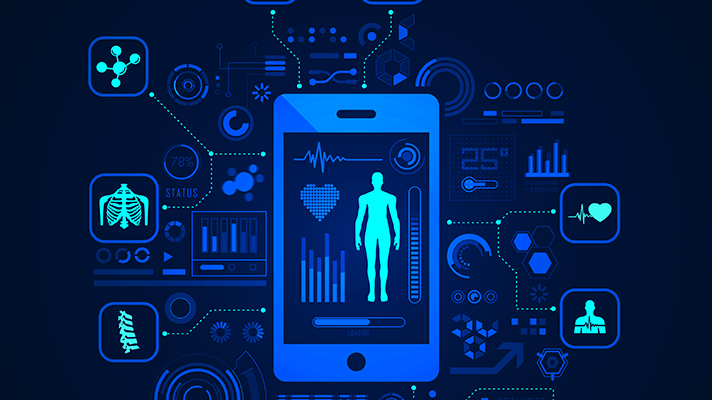FDA Unlocks the Key to Innovation in Interoperable Medical Devices
Interoperability holds the key to interconnected medical devices. A recent De Novo classification of a software for diabetes management shows the way forward.
We live in an interconnected world. At home, at work, and in public places, we are using devices and systems that are connected to the internet and to each other. Nearly every aspect of our lives is now dependent on these smart devices. Think of how many things you can do just by using your smartphone!
This is called the Internet of Things (IoT), no longer a buzzword!
The Internet of Medical Things (IoMT) is now catching on in the healthcare industry with eye-popping projections of market growth, but still remains a distant aspiration. According to a 2018 report from Deloitte, the IoMT market is expected to grow from $41 billion in 2017 to $158 billion by 2022. The medical device portion of this market also shows an impressive growth potential going from $15 billion to $52 billion in 5 years. Another report from McKinsey projects an era of exponential improvement in healthcare, where technology-driven innovation could create between $350-$410 billion in annual value by 2025!
Clearly these are very impressive projections that should drive interest and investment from all stakeholders in the industry.
However, there are significant barriers to achieving these lofty goals. First, the market is not yet ready to sufficiently value these innovations. The second is that the regulatory framework is not evolving fast enough to facilitate timely marketing authorization of connected medical devices. Indeed, the same 2018 Deloitte report reveals that 71% of the 237 respondents working in MedTech companies believe that healthcare providers and clinicians are not ready to utilize data generated from connected medical devices. Further, 67% of them believe that the regulatory framework will not catch up for another 5 years.
In this blog, we are focusing on a recently cleared innovation in the challenging space of diabetes management that highlights some of the key ingredients of success for innovative, connected medical devices.
Regulatory Breakthrough
In a small step towards achieving the vision of interoperable medical devices, the FDA has recently authorized marketing of a novel software medical device using the De Novo Classification. This is a regulatory pathway for novel devices which cannot utilize an existing predicate device for 510(k) clearance, and they are not high risk to need approval through the longer PMA pathway. As a result, this software device now can be used as a predicate for future similar devices so that such innovation can be to market.
This is a significant development. The software device called Control-IQ is considered an interoperable automated glycemic controller, used with a compatible integrated continuous glucose monitor (iCGM) and an insulin pump. This closed loop system is called an automated insulin dosing (AID) system, which allows customization of the diabetes treatment to an individual patient as illustrated in the graphic below.
The key to making this work is interoperability, which according to the FDA is “the ability of two or more products, technologies or systems to exchange information and to use the information that has been exchanged”. Information can be used in many ways such as displaying, storing, interpreting, analyzing and issuing a command to control another product.
The Control-IQ technology, for example, collects the glucose readings from the Dexcom G6 iCGM, and uses this data along with user inputs, such as exercise and sleep schedule, carbohydrate intake, etc., to predict the glucose level 30 minutes in the future. Insulin delivery by the t:slim X2 pump is adjusted based on the prediction to keep the blood glucose level in range. Control-IQ can also suspend basal insulin delivery when the predicted glucose level is on the low end of the range and deliver a correction bolus insulin when the predicted glucose level is on the high end. Interoperability allows the communication between the iCGM, Control-IQ and the insulin pump in a closed loop system. The regulatory breakthrough achieved using the De Novo process now opens the gateway for more innovative interoperable devices to come to market.
“The marketing authorization of this first stand-alone interoperable automated glycemic controller also allows substantially equivalent controller technologies that are developed for diabetes in the future to go through the 510(k) review process, helping to promote timely patient access to innovative technologies that can improve their care and quality of life”.
-FDA annoucement
Market Forces
Diabetes is a chronic, life-threatening disease which affects an estimated 425 million people worldwide and projected to reach 629 million by 2045. At the same time, it is a very difficult disease to manage because every individual patient is different and requires a customized approach. As a result, there is a lot of opportunity for smaller companies to innovate so they can compete in this large and growing space against established players. Tandem Diabetes Care is one such company that has taken a technology-driven, collaborative approach to accelerate innovation around their flagship t:slim X2 insulin pump. 2018 sales were $184 million (+71% over 2017), which are projected to nearly double in 2019! Although, still considerably small compared to the giants such as Medtronic (2018 Diabetes Group Sales $1.2 billion), the growth rate is very impressive.
In the current market, it is nearly impossible for one company to develop and launch a closed-loop, customizable diabetes management system on its own. Interoperability allows companies to focus on their core strength (e.g. glucose monitoring, insulin pump, insulin pens, prefilled syringes etc.) while collaborating with others to rapidly market their innovations.
Way Forward - How Quality/Regulatory Functions can Help
There are still significant hurdles to developing and launching interoperable medical devices.
Here are a few ways Quality and Regulatory functions can help their organizations achieve market success:
Strengthen risk management – Interoperable devices pose a higher level of risk due to various interfaces with other devices and users. Risk analysis has always been critical for medical devices, but now takes on a new significance. There needs to be a strong focus on security, which includes both privacy and cybersecurity, as well as patient safety. Human factors engineering is increasingly important. Subject matter expertise in these areas needs to be brought together in a coherent, comprehensive operational model of risk management for it to be truly effective in enabling rapid innovation.
Strengthen design controls, especially V&V – FDA expects a stronger focus on different electronic interfaces, and verification/validation (V&V) across these interfaces with appropriate consideration of the role of different users, and expected use and misuse scenarios. The medical device should work correctly prior to delivery, during the integration process and continue to work while in use and through maintenance and release of software updates. De Novo classifications, such as those of the Control-IQ technology (DEN190034), are a good source of special controls (V&V, labeling etc.) the FDA expects for interoperable devices.
Strengthen post-market surveillance – Risks related to security and safety of interoperable devices are expected to evolve over time as these devices are used in diverse clinical situations. No matter how good your risk management and design control processes are, there is no way you can anticipate all emerging risks. The post-market process needs to evolve from passive monitoring through trending to signal detection, evaluation and confirmation. The link between post-market and the design process needs to be strengthened to facilitate software updates or other risk-mitigating actions such as labeling or user training. In this way, the post-market surveillance process becomes a key enabler of innovation through a lifecycle risk management for interoperable medical devices.
Monitor and influence evolving standards – One of the main challenges for interoperable medical devices is the lack of standards for security and communication across different device interfaces. Healthcare ecosystem is complex, and, unlike the plug-and-play world of consumer electronics, open interoperability is not that easy. Still, there is a lot of work being done in this area and FDA continues to recognize various consensus standards for interoperability. A quick search on the FDA consensus standards database using the keyword “interoperability” shows 32 standards. One such standard recently published is ANSI/AAMI/UL 2800-1: Standard for Safety for Medical Device Interoperability. There are additional domain specific standards and guidance documents under development, including significant work around cybersecurity. There is an opportunity for the industry to get involved with other stakeholders to shape the direction of these standards.
Develop an agile, resilient regulatory strategy – FDA finalized its guidance on design considerations and premarket submission for interoperable medical devices in September 2017. This is a new area for regulatory oversight and things are changing fast. FDA is also working on a software precertification pilot which should influence the regulatory approach to software as a medical device. Engagement with the FDA through the pre-submission process is critical. A right mix of pre-market and post-market data based on benefit-risk can make a big impact on the launch timeline. Global regulatory requirements are also evolving and far from being harmonized. Such rapid changes require an agile and resilient regulatory strategy.
In conclusion, interoperability offers a significant opportunity to realize the huge potential of connected medical devices. However, there are significant hurdles, both from the market and regulatory perspective. The case of Control-IQ technology offers a path forward for innovative players in the industry to compete in challenging diagnostic and treatment applications by leveraging interoperability. The regulatory environment is also evolving to facilitate rapid innovation in this field.
Share your comments and questions below. Contact us and let us know how we can help.
References
2018 Deloitte Report – MedTech and the Internet of Medical Things, July 2018
McKinsey Report – The Era of Exponential Improvement in Healthcare, May 2019
De Novo Classification for Novel Medical Devices, November 2019
Control-IQ Technology from Tandem Diabetes Care
FDA Announcement – First Interoperable Automated Insulin Dosing Controller, December 2019
Tandem Diabetes Care Annual Report
FDA Database for Recognized Consensus Standards
FDA Guidance – Design Considerations and Pre-market Submission Recommendation for Interoperable Medical Devices, September 2017
You may also like these articles:
The Real Goal of Medical Device Safety Surveillance
5 Key Changes in ISO 14971:2019
Tale of Two Acquisitions


